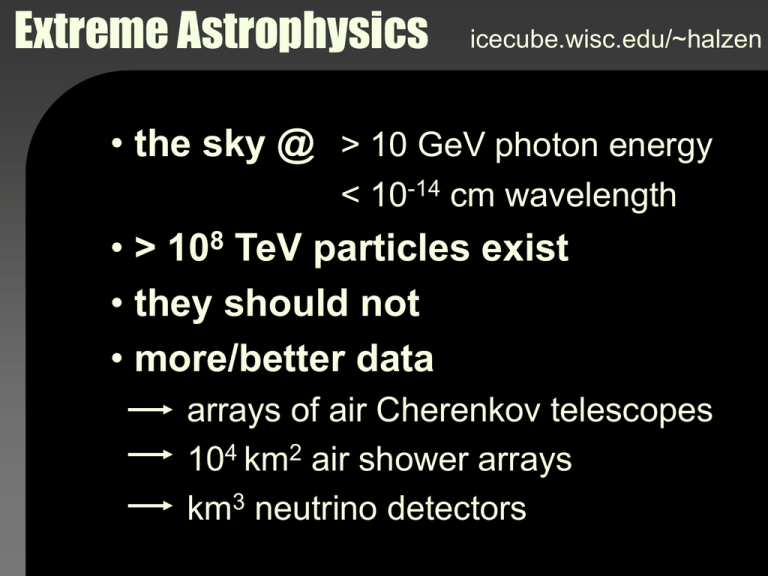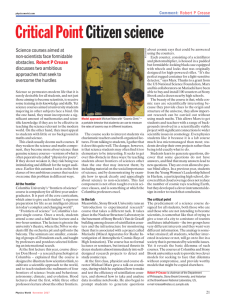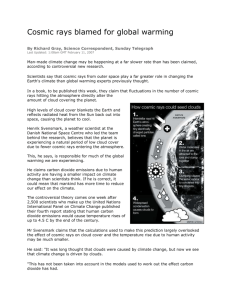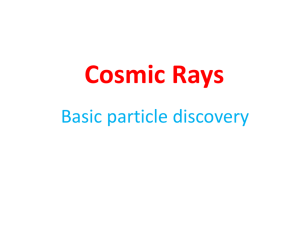PPT - IceCube
advertisement

Extreme Astrophysics icecube.wisc.edu/~halzen • the sky @ > 10 GeV photon energy < 10-14 cm wavelength • > 108 TeV particles exist • they should not • more/better data arrays of air Cherenkov telescopes 104 km2 air shower arrays km3 neutrino detectors CMB Radio Visibe GeV g-rays Flux Energy (eV) 1 TeV Particle propagation in the Universe protons E>1019 eV (30 MLy) neutrinos gammas (0.01 - 3 MLy) protons E<1019 eV Photons: Protons/nuclei: Cosmic accelerator absorbed on dust and radiation; deviated by magnetic fields, reactions with radiation (CMB) With 103 TeV energy, photons do not reach us from the edge of our galaxy because of their small mean free path in the microwave background. g + gCMB + e + e Interaction length of protons in microwave background p + gCMB p+n lgp = ( nCMB p+g s CMB ) -1 @ 10 Mpc GZK cutoff energy > 5 107 TeV / / / / / / / TeV sources! / / cosmic / rays / / / / / / / n GeV g-rays Visible CMB Radio Flux Energy (eV) Multi-Messenger Astronomy protons, g-rays, neutrinos, gravitational waves as probes of the high-energy Universe 1. protons: directions scrambled by magnetic fields 2. g-rays : straight-line propagation but reprocessed in the sources, extragalactic backgrounds absorb Eg > TeV 3. neutrinos: straight-line propagation, unabsorbed, but difficult to detect Telescope User date Intended Use Actual use Optical Galileo 1608 Navigation Moons of Jupiter Optical Hubble 1929 Nebulae Expanding Universe Radio Jansky 1932 Noise Radio galaxies Micro-wave Penzias, Wilson 1965 Radio-galaxies, noise X-ray Giacconi … 1965 Sun, moon Radio Hewish, Bell 1967 Ionosphere Pulsars g-rays military 1960? Thermonuclear explosions Gamma ray bursts 3K cosmic background neutron stars accreting binaries New Window on Universe? Expect Surprises the accelerators cosmic rays T. Gaisser 2005 ~E-2.7 Nature accelerates particles 10 7 times the energy of LHC! knee 1 part m -2 yr-1 Ankle 1 part km-2 yr-1 where? how? LHC ~E-3 ~E-2.7 Galactic and Extragalactic Cosmic Rays Knee Ankle extragalactic cosmic rays the highest energies Acceleration to 1021 eV ? 2 ~10 Joules ~ 0.01 MGUT dense regions with exceptional gravitational force creating relativistic flows of charged particles, e.g. • dense cores of exploding stars • supermassive black holes • merging galaxies solar flare shock acceleration Coronal mass ejection 09 Mar 2000 Cas A Supernova Remnant in X-rays Shock fronts Fermi acceleration John Hughes, Rutgers, NASA Active Galaxy Radiation Field: Ask Astronomers • energy in protons ~ energy in electrons • photon target observed in lines >> few events per year km2 Active Galactic Nucleus (Artist Impression) Jets Shock fronts Fermi acceleration Black Hole Accretion Disk Gamma Ray Bursts Fireball: Rapidly expanding collimated jet of photons, electrons and positrons becoming optically thin during expansion Shocks: external collisions with interstellar material (e.g. remnant— guaranteed TeV neutrinos!!!) or internal collisions when slower material is overtaken by faster in the fireball. Protons and photons coexist in the fireball sources of the highest energy cosmic rays ? Cosmic Accelerators E ~ G qvBR R~ 2 GM/c energy magnetic field E ~ G qBM boost factor mass pulsar E (eV) = B (Tesla) 2 R (m) 2p __ T R B T-1 ms-pulsar 10 km 108 T 103 Fermilab few km few T 105 (#revs-1) E 1019 eV ~1012 eV = 1 TeV ! E~GBM E > 1019 eV ? • quasars G @ 1 B @ 103G M @ 109 Msun • blasars G >~ 10 • neutron stars G @ 1 B @ 1012G M @ Msun black holes .. • grb G >~ 102 emit highest energy g’s! models of cosmic rays Bottom up – GRB fireballs – Jets in active galaxies – Accretion shocks in galaxy clusters – Galaxy mergers – Young supernova remnants – Pulsars, Magnetars – Mini-quasars –… • Observed showers either protons (or nuclei) Top-down – Radiation from topological defects – Decays of massive relic particles in Galactic halo • mostly pions (neutrinos, photons, not protons) Disfavored! • Highest energy cosmic rays are not gamma rays • Overproduce TeV-neutrinos 1024 eV = 1015 GeV ~_ MGUT are cosmic rays the decay product of • topological defects ? (vibrating string, annihilating monopoles) •heavy relics ? Top. Def. X,Y W,Z quark + leptons • top-down spectrum • hierarchy n >> g >> p Georges Lemaitre believed that cosmic rays where primordial radiation from the Big Bang detection of cosmic rays Cosmic Rays Observations first discovered in 1912 by Austrian scientist Victor Hess, measuring radiation levels aboard a balloon at up to 17,500 feet (without oxygen!) the Earth’s atmosphere as the detector Cherenkov radiation cherenkov radiation: particle’s speed exceeds the speed of light Copyright © 2001 Purdue University Use the Phenomenon of Cherenkov light How to Build a n Detector 1019 eV proton 6 km p g e m p0 p+ p- 12 km g g nm m+ n me+ e- e+ g e+ em+ g e+ n ne m electrons/positrons muons photons neutrons Akeno giant air Shower array AGASA ~ 100 km2 Typical HiRes Stereo Events HiRes 2 HiRes 1 Mirror and Camera HiRes in Utah Desert mirror Typical HiRes Stereo Events • HiRes 2 • HiRes 1 Two Spectra: HiRes Mono and Fly’s Eye Stereo HiRes-1: 6/97-2/03 HiRes-2: 12/99-9/01 • Excellent agreement between HiRes I and II. • HiRes Stereo soon! AGASA @#>?& ! Auger combine two succesful techniques • fluorescence eye with active photodetectors (HiRes) • ground array of particle detectors (AGASA) Galactic and Extragalactic Cosmic Rays Knee 1 event km-2 yr-1 Ankle extragalactic cosmic rays the highest energies Auger: on its way towards resolving the discrepancy proton astronomy ? Pointing: dB d ___ ____ ~ = = E Rgyro ___ ~ 0.1o = [ d ______ 1 Mpc ][ B ______ 10-9 G ] E _________ 3 x 1020 eV B ~ 10-6 Gauss in local cluster?








